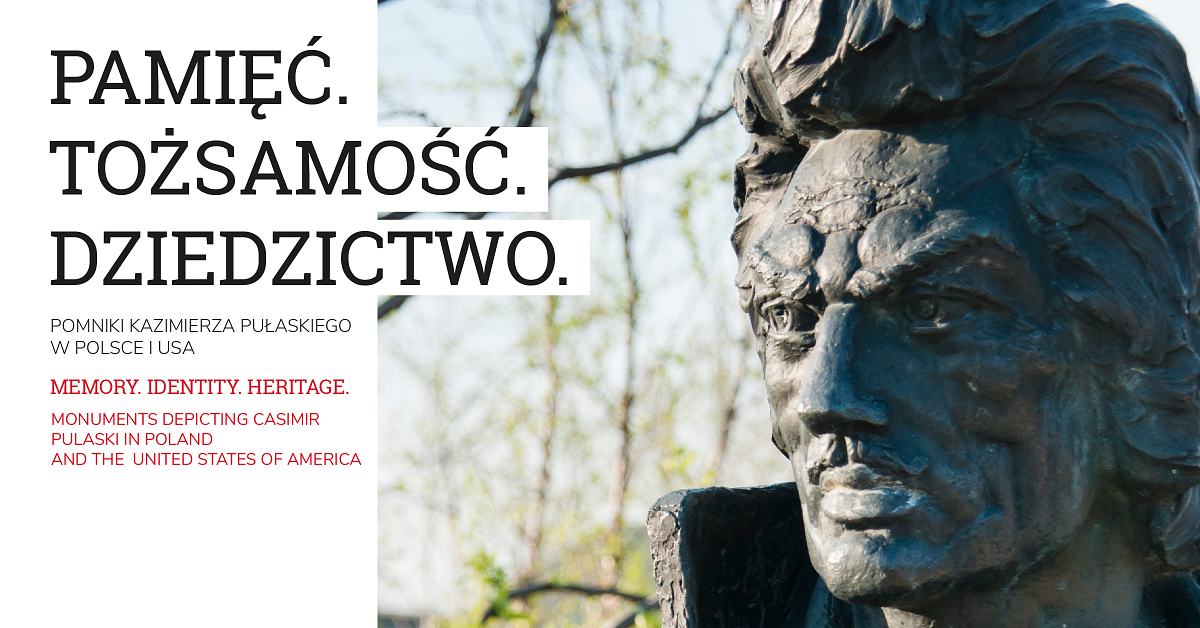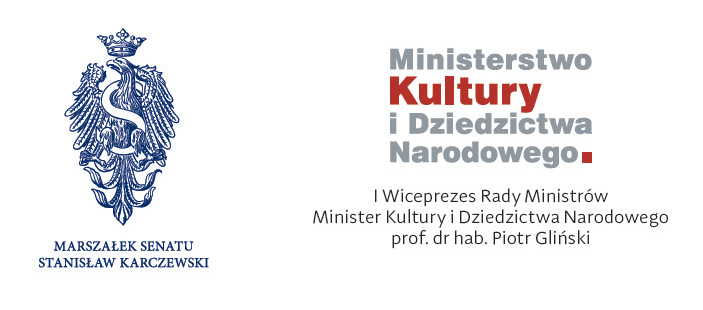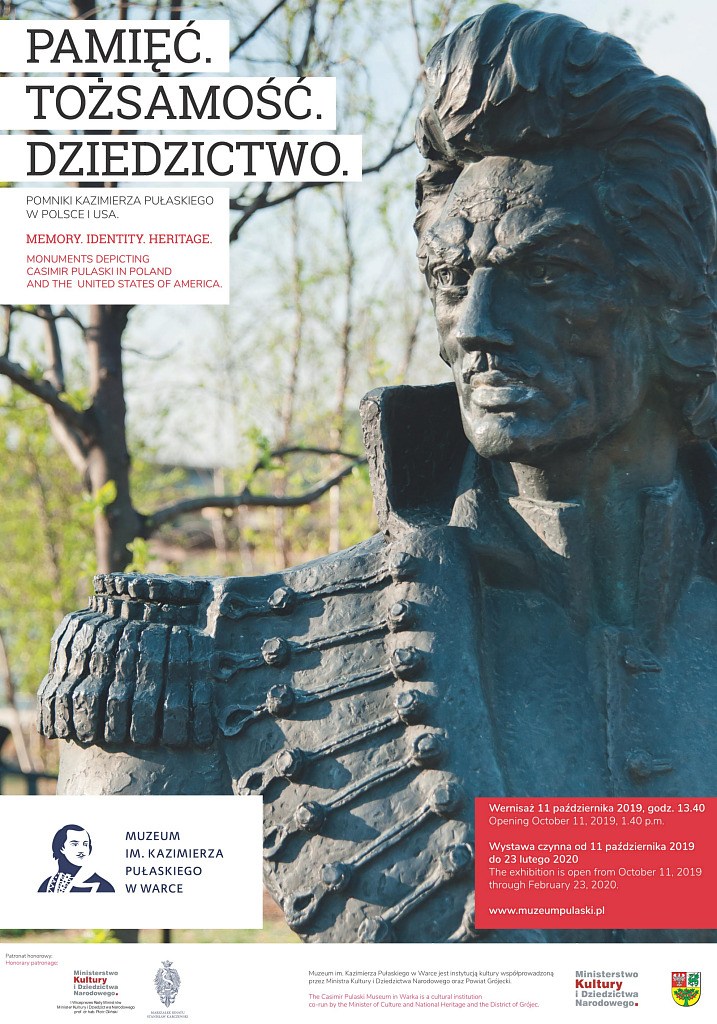
Memory. Identity. Heritage. Monuments
depicting Casimir Pulaski in Poland and the United States of America.
The exhibition is open from October 11, 2019 through February 23, 2020.
Monuments: “They universally speak about an individual as such and their role in the community; about the acts and merits of the individual vs. collective actions. Finally, it also speaks about the community–not only about the one it is supposed to commemorate, but also about the one in which it is rooted; the monument is therefore a "signum temporis"; it testifies to the social, political, and national values, and the era in which it springs to life.”
Irena Grzesiuk-Olszewska, Warszawska rzeźba pomnikowa, Warszawa 2003
Dear Reader,
We are proud to present the exhibition entitled “Memory. Identity. Heritage. Monuments depicting Casimir Pulaski in Poland and the United States of America,” designed to commemorate the 240th anniversary of Casimir Pulaski’s death.
General Pulaski has been immortalized through numerous literary, art, historical, and even music works, yet his monuments deserve our special care and attention. Equestrian statues and other memorials dedicated to pay homage to the Hero of Two Nations have been unveiled in many American cities and towns. They are a living testimony to the fact that the Polish-American community has never ceased to remember the hero and the times in which these monuments were built; they are a tribute to the Polish-American soldier, but they also speak to the communities that funded and dedicated them. In Poland, Casimir Pulaski has been commemorated through nine memorials, dedicated primarily in communities with whom he had certain bonds.
In the United States, General Pulaski has been celebrated through equestrian and full-figure statues, busts, steles, plaques with reliefs, and large, architectural monuments in addition to highways, bridges, counties, cities, towns, and schools bearing his name. However, today’s exhibition defines the memorial in terms of a sculptural work. Such monuments have been dedicated alongside Pulaski's route on the East Coast and in communities with a numerous Polish-American population. They have assumed the role of a symbol attesting to the fact that these communities have not forgotten their history and Polish roots. As such, the memorials we are presenting today help build identity and constitute an integral part of the Polish heritage.
The Polish-American community was usually first to take the initiative to dedicate monuments to the Hero of Two Nations. Polish organizations, parishes, and veterans would collect the necessary funds. However, there have also been various American projects, such as the one in Little Rock, AR or Philadelphia, PA, where the Pulaski monument was unveiled thanks to General William M. Reilly of the Pennsylvania National Guard. Frequently, the construction and dedication ceremonies coincided with festive celebrations of important Pulaski’s birth and death anniversaries as well as the 150th and 200th anniversaries of the United States of America and the millennial anniversary of Poland.
The oldest Pulaski monument is located in Monterey Square in Savannah, GA. On November 17, 1779, a mere several weeks after the hero’s tragic death, General Washington issued a password to identify friends from foes when crossing military lines: ‘Query: Pulaski, Response: Poland.’ What is more, on November 29, 1779, US Congress decided that a monument to commemorate Pulaski were to be dedicated in Savannah. However, it was not until 1854 that the memorial was unveiled thanks to the efforts of the community of the state of Georgia. In 1867, General Pulaski’s bust by Henryk Dmochowski appeared on the Capitol Hill, featured among other busts of national heroes. In May 1910, President William Taft held a speech at the dedication ceremony of an equestrian statue depicting Casimir Pulaski, applauded by tens of thousands of Polish-Americans, who flocked to Washington, D.C. for the event.
This event sparked a greater interest in Casimir Pulaski in his homeland. The community of Krynica Zdrój in the south of Poland unveiled a memorial to Pulaski in connection with his role in the Bar Confederation. A high mound was formed, and in 1929, a Pulaski obelisk was dedicated, mainly thanks to a local physician Dr. Franciszek Kmietowicz, MD (1863-1939).
The solemn celebrations marking important anniversaries of Pulaski's death, both in Poland and the USA, were accompanied by dedication ceremonies of new memorial sites. In 1929, a bust was unveiled in Paterson, NJ. In 1930, a full-figure monument featuring the general in a long coat was dedicated in Utica, NY. In 1947, one of the most impressive sculptural depictions of Pulaski–a slender figure of the proud general wielding a sword–was erected next to the Philadelphia Museum of Art in Philadelphia, PA. A large relief was dedicated in 1951 in Patterson Park in Baltimore, MD. The bust unveiled in Little Rock, AR, where Pulaski bears a canning resemblance to Elvis Presley, is likely to bring a smile to the faces of unsuspecting tourists.
Today’s exhibition "Memory. Identity. Heritage..." brings us a step closer to the above projects. It also shows that the memory of Pulaski is deeply rooted in the hearts of Polish and American patriots. The presented memorials shall embody these emotions for the generations to come. Casimir Pulaski has become a symbol of the struggle for freedom, the Polish-American community, and Polish-American bonds.
May the exhibition be a source of a myriad of positive emotions for all Visitors.
Iwona Stefaniak
Director of the Casimir Pulaski Museum in Warka
Zdjęcia:
Popiersie Kazimierza Pułaskiego / Casimir Pulaski Bust, 1961, Little Rock, Arkansas, Pulaski County, fot. Terry Smith Images, Alamy Stock Photo
Pomnik Generała Kazimierza Pułaskiego / General Casimir Pulaski Monument, William M. Reilly Memorial, 1947, Philadelphia, Pennsylvania, fot. Alexandra Rospond
Pomnik Generała Kazimierza Pułaskiego / General Casimir Pulaski Monument, 1910, Washington, D.C., fot. William S. Kuta, Alamy Stock Photo
Pomnik Kazimierza Pułaskiego / General Casimir Pulaski Monument, 1979, Warka, fot. Rafał Donica
-
 Title
Title
Title
Title
-
 Title
Title
Title
Title
-
 Title
Title
Title
Title
-
 Title
Title
Title
Title
-
 Title
Title
Title
Title
-
 Title
Title
Title
Title
-
 Title
Title
Title
Title
-
 Title
Title
Title
Title
-
 Title
Title
Title
Title
-
 Title
Title
Title
Title
-
 Title
Title
Title
Title
-
 Title
Title
Title
Title
-
 Title
Title
Title
Title
-
 Title
Title
Title
Title
-
 Title
Title
Title
Title
-
 Title
Title
Title
Title
-
 Title
Title
Title
Title
-
 Title
Title
Title
Title
-
 Title
Title
Title
Title
-
 Title
Title
Title
Title
-
 Title
Title
Title
Title
-
 Title
Title
Title
Title
-
 Title
Title
Title
Title
-
 Title
Title
Title
Title
-
 Title
Title
Title
Title
-
 Title
Title
Title
Title
-
 Title
Title
Title
Title
-
 Title
Title
Title
Title
-
 Title
Title
Title
Title
-
 Title
Title
Title
Title
-
 Title
Title
Title
Title
-
 Title
Title
Title
Title
-
 Title
Title
Title
Title
-
 Title
Title
Title
Title
-
 Title
Title
Title
Title
-
 Title
Title
Title
Title
-
 Title
Title
Title
Title
-
 Title
Title
Title
Title
-
 Title
Title
Title
Title
-
 Title
Title
Title
Title
-
 Title
Title
Title
Title
-
 Title
Title
Title
Title
-
 Title
Title
Title
Title
-
 Title
Title
Title
Title
-
 Title
Title
Title
Title
-
 Title
Title
Title
Title
-
 Title
Title
Title
Title
-
 Title
Title
Title
Title
-
 Title
Title
Title
Title
-
 Title
Title
Title
Title
-
 Title
Title
Title
Title
-
 Title
Title
Title
Title
-
 Title
Title
Title
Title
-
 Title
Title
Title
Title
-
 Title
Title
Title
Title
-
 Title
Title
Title
Title
https://www.muzeumpulaski.pl/en/archiwum-aktualnosci-2019/624-memory-identity-heritage-monuments#sigProId4d1b058eab
Pamięć. Tożsamość. Dziedzictwo.
Pomniki Kazimierza Pułaskiego w Polsce i USA.
Memory. Identity. Heritage.
Monuments depicting Casimir Pulaski in Poland and the United States of America.
Wystawa czynna od 11 października 2019 do 23 lutego 2020
The exhibition is open from October 11, 2019 through February 23, 2020.
Koncepcja wystawy / Concept by Iwona Stefaniak
Kurator wystawy / Curator Iwona Stefaniak
Współpraca / in cooperation with Karol Kucharski, Piotr Kupnicki
Konsultant ds. współpracy polsko-amerykańskiej Dr Iwona Świątczak-Wasilewska / Polish-American Cooperation Consultant Iwona Świątczak-Wasilewska, Ph.D.
Współpraca w USA / in cooperation with Peter Obst, Philadelphia, PA
Tłumaczenia / Translated by Joanna Łukasiak-Hołysz
Projekt, aranżacja wystawy / Designed and Arranged by HANDSOME STUDIO - Dorota Skalska-Stefańska, Maciej Stefański, Ewa Hiller, Jarosław Bartoszek
Podziękowania dla instytucji, organizacji i osób, które pomogły zgromadzić materiały do wystawy / We wish to express our deepest gratitude and appreciation to following institutions, organizations, and individuals:
Polska / Poland:
Konrad Nawrot, administrator Oś. Śródmieście w Rzeszowie / Śródmieście Housing Development Administrator Konrad Nawrot
Stanisław Lenar, autor pomnika w Rzeszowie / Artist behind the Pulaski monument in Rzeszów Stanisław Lenar
Marian Szajda, autor pomnika w Nowym Żmigrodzie / Artist behind the Pulaski monument in Nowy Żmigród Marian Szajda
Piotr Zientarski, Senator RP / Senator of the Republic of Poland Piotr Zientarski
Franciszek Ratajczyk, Włocławek / Franciszek Ratajczyk from Włocławek
Małgorzata Bisaga, dyrektor I LO we Włocławku / Principal of the First High School in Włocławek Małgorzata Bisaga
Tomasz Dobosz, dyrektor Zespołu Szkół Mechaniczno-Elektrycznych im. K. Pułaskiego w Częstochowie / Principal of the Casimir Pulaski School of Mechanical and Electrical Engineering in Częstochowa Tomasz Dobosz
Janusz Kieblesz, Tylicz / Janusz Kieblesz from Tylicz
Eryk Kotkowicz, Muzeum Rolnictwa w Ciechanowcu / Eryk Kotkowicz with the Agriculture Museum in Ciechanowiec
Anna Kowal, Koszalińska Biblioteka Publiczna im. Joachima Lelewela / Anna Kowal with the Joachim Lelewel Public Library in Koszalin
Rafał Kocoł, Muzeum Okręgowe w Rzeszowie / Rafał Kocoł with the District Museum in Rzeszów
Katarzyna Liana, Muzeum Regionalne PTTK w Gorlicach / Katarzyna Liana with the Polish Tourist and Sightseeing Society Museum in Gorlice
Maciej Batorek, Wiceprzewodniczący Towarzystwa Przyjaciół Częstochowy / Vice-president of the Częstochowa Town Boosters Maciej Batorek
Stany Zjednoczone / United States of America:
Dorothy Zduniak-Szychulski, Henry Szychulski, Saint Joseph’s History Society of South Camden, NJ
Barclay Gibson, Pulaski, TX
J. J. Prats, Editor, Historical Marker Database
Bryan Simmons, photographer, Northampton MA, Providence RI, Fall River MA, Schenectady NY
J. Don Morfe, photographer, Baltimore, MD
Mark Hilton, photographer, Little Rock, AR
Cosmos Mariner, photographer, Northampton, MA
Laurie Hoffman, Executive Assistant to Mayor Daniel Horrigan, City of Akron, OH
Carlen Hatala, Senior Planner, Historic Preservation, City of Milwaukee, WI
Nader Sayadi, photographer, City of Milwaukee, WI
Laurie E. Jasinski, Research Editor, Handbook of Texas, Texas State Historical Association, TX
Anne D. Conway, Director, Museum of Work and Culture, Woonsocket, RI
Chris Bourdon, City of Meriden, CT
Sonny Hugley, ‘My City Savannah Tour,’ Savannah, GA
Sara Theroux, Production Specialist, Stevens Point, WI
Mike Wiza, Mayor of the City of Stevens Point, WI
John Quirk, Community Media Manager, City of Stevens Point, WI
Bobby J. Sulecki, Erie Polonia History, PA
Fred Zimnoch, Polish Heritage Committee of Northampton, MA,
Aurore Eaton, Manchester Heritage Commission, The Pulaski Monument Committee, NH
Erie County Public Library, PA
Mary Ann Moran-Savakinus, Lackawanna Historical Society, Scranton PA
Cynthia Van Ness, MLS, Director of Library & Archives, Research Library, The Buffalo History Museum
Erica Manczuk Stocks, Polish American Citizens Club, Dorchester, MA
Philip A. Bean, Ph.D. Executive Director Central New York Conservancy, Utica, NY
Dona M. McDermott, Archivist, Valley Forge National Historical Park, PA
Camille Pryputniewicz, Utica, NY
Bethany Dhunjisha, Valley Forge National Historical Park, PA
Paul Buckley, Producer/Director, City of Utica, NY
John and Kerry Dyke, Perth Amboy, NJ
Do wystawy wykorzystano fotografie i materiały:
ze zbiorów Muzeum im. Kazimierza Pułaskiego w Warce
ze zbiorów Johna Szucha, Seville, Ohio, USA
Edwarda Pinkowskiego, Fundacja Polacy w Ameryce, Fliladelfia, USA
Smithsonian American Art Museum’s online Inventory of American Sculpture Database The Historical Marker Database - www.hmdb.org
The exhibitions features photographs and materials:
from the collections of the Casimir Pulaski Museum in Warka
from the collection of John Szuch, Seville, Ohio, USA
from the collection of Edward Pinkowski, Poles in America Foundation, Philadelphia, USA
Smithsonian American Art Museum’s Online Inventory of American Sculpture Database
The Historical Marker Database - www.hmdb.org.
Honorary Patronage




